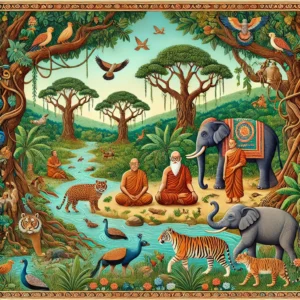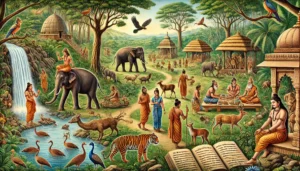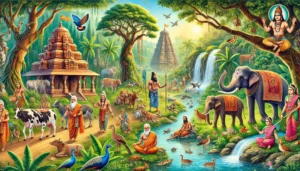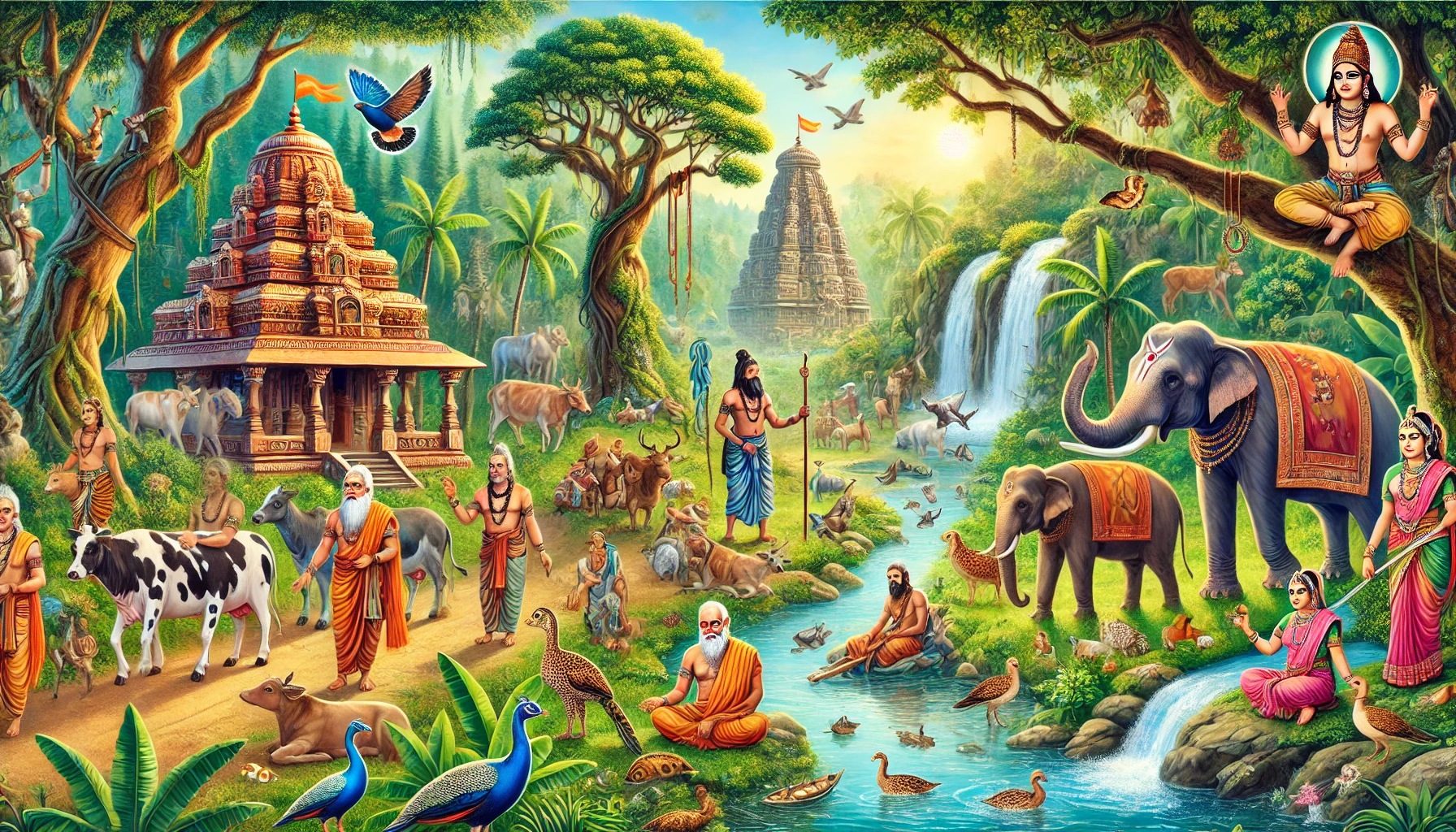
Animal Conservation in Ancient Indian
Animals and Biodiversity Preservation in Ancient Indian Practices
The Indian subcontinent has long been a cradle of biodiversity, home to diverse ecosystems ranging from dense rainforests to vast grasslands and riverine systems. Ancient Indian civilization not only recognized this natural wealth but also devised ethical, religious, and practical frameworks for preserving it. Unlike modern conservation efforts that often arise from crisis management, ancient India’s environmental ethics were deeply ingrained in daily life, spiritual beliefs, and governance.
This article explores how ancient Indian traditions, scriptures, and state policies contributed to the conservation of animals and biodiversity, providing valuable lessons for modern sustainability.
1. The Spiritual Significance of Animals and Biodiversity
Ancient Indian thought saw nature as divine and interconnected. The belief in Vasudhaiva Kutumbakam (the world is one family) extended to all living beings, fostering a compassionate approach to conservation.
A. Animals in Hinduism
In Hindu tradition, animals were often seen as sacred beings and companions of deities, ensuring their protection through religious reverence.
- Cow (Gau Mata) – Considered a universal mother, the cow was associated with wealth and prosperity. The Rigveda frequently mentions cows as symbols of nourishment, and their protection was emphasized in several Smritis.
- Elephant (Gajendra) – The elephant was associated with Lord Indra as Airavata and with Lord Ganesha, symbolizing wisdom and royal power.
- Tiger (Vyaghra) – The tiger was seen as a guardian and a vehicle of Goddess Durga, reinforcing its importance in the ecosystem.
- Peacock (Mayura) – Sacred to Lord Kartikeya and associated with Lord Krishna, the peacock was protected across many regions.
- Serpents (Nagas) – Worshipped during Nag Panchami, serpents were revered, which contributed to the conservation of reptiles.
- Monkeys (Vanaras) – Hanuman, a revered deity, was depicted as a monkey, preventing harm to the species.
B. Animals in Jainism and Buddhism
- Jainism upheld the principle of Ahimsa (non-violence) at an extreme level, protecting even microorganisms and insects. Jain monks used soft brooms to sweep the ground before walking to avoid harming tiny creatures.
- Buddhism promoted kindness toward all beings, with Buddha himself advocating for vegetarianism and the compassionate treatment of animals. Buddhist monasteries, often located in forested areas, became de facto wildlife sanctuaries.
C. Totemism and Tribal Conservation Ethics
Many indigenous communities in India have followed totemism, associating themselves with specific animals as their clan symbols, ensuring their protection. Tribes such as the Bhils, Santhals, and Gonds maintained traditions that safeguarded biodiversity by restricting hunting and deforestation.
Table of Contents

Animal Conservation in Ancient Indian
2. Sacred Forests and Conservation Practices
A. The Concept of Sacred Groves (Devrai)
Ancient Indians protected biodiversity through Devrais—forests dedicated to local deities where cutting trees or hunting animals was forbidden. Even today, many of these sacred groves survive, hosting unique species found nowhere else.
Examples:
- The Kavus of Kerala are preserved for serpent worship.
- The Mawphlang sacred forests of Meghalaya belong to indigenous Khasi communities.
- The Sarna sacred groves of central India are protected by tribal communities.
B. Forest Conservation in Texts
- Vedas describe forests as the abode of sages and divine forces, urging humans to maintain ecological harmony.
- Arthashastra (by Kautilya) laid out policies for forest management, including protected reserves (Abhayaranyas), where hunting and deforestation were regulated.
- Ramayana and Mahabharata highlight the role of forests (Vana) as places of learning, meditation, and biodiversity conservation.
C. Ancient India’s Afforestation and Agroforestry
Sustainable land-use practices such as Vrikshayurveda (ancient botany) emphasized afforestation, tree conservation, and agroforestry techniques that prevented soil erosion and maintained ecosystem balance.
3. Water Conservation and Aquatic Biodiversity
Ancient Indian society understood the importance of water bodies in sustaining biodiversity. Several measures were taken to preserve aquatic life:
- Rivers as Divine Entities – The Ganges, Yamuna, Godavari, and Saraswati were revered as goddesses, preventing pollution and overuse.
- Temple Ponds (Pushkarni) – Water bodies near temples acted as microhabitats, sustaining local fish and bird species.
- Traditional Fisheries Management – Ethical fishing practices ensured that fish populations were not overexploited, maintaining aquatic biodiversity.
4. Wildlife Protection Laws and Governance in Ancient India
A. Arthashastra’s Conservation Laws
Kautilya’s Arthashastra (4th century BCE) prescribed detailed laws for wildlife and environmental conservation, including:
- Protection of elephants in royal forests (Hastivanas).
- Punishments for harming protected animals and trees.
- Prohibition of unrestricted hunting.
B. Manusmriti and Other Texts on Environmental Ethics
- Manusmriti forbids unnecessary killing of animals and prescribes ethical treatment of all life forms.
- Yajnavalkya Smriti outlines penalties for harming animals and polluting rivers.
5. Sustainable Agriculture and Pastoral Practices
A. Organic and Sustainable Farming
- Crop rotation, intercropping, and mixed farming were practiced to maintain soil fertility and support pollinators.
- Farmers avoided excessive irrigation and used natural fertilizers like cow dung and compost.
B. Protection of Grazing Lands
- Reserved lands (Gauchar) were dedicated for cattle grazing to prevent overgrazing and promote ecological balance.

Animal Conservation in Ancient Indian
6. Modern Relevance of Ancient Indian Conservation Practices
While modern conservation policies often focus on crisis-driven solutions, ancient Indian practices offer a holistic approach that integrates spirituality, ethics, and sustainability.
Lessons for Today
- Reviving Sacred Groves – Protecting forests through cultural and religious significance.
- Sustainable Agriculture – Encouraging organic farming and biodiversity-friendly practices.
- Water Conservation – Implementing traditional water management techniques.
- Wildlife Protection – Promoting the idea of Ahimsa in contemporary conservation policies.
By rediscovering and integrating these ancient traditions into modern environmental policies, we can foster a sustainable future in harmony with nature.
Conclusion
Ancient Indian civilization demonstrated a remarkable understanding of ecological principles, blending them with religious, cultural, and ethical frameworks. From the sacredness of animals to the preservation of forests and water bodies, India’s historical conservation ethos serves as a guiding light for modern efforts in biodiversity preservation.
By revisiting and respecting these traditions, we can work toward restoring ecological balance and protecting the planet for future generations.
FAQs on “Animals and Biodiversity in Ancient Indian Practices: Preservation and Sacred Traditions”:
- How did ancient Indian traditions contribute to biodiversity preservation?
Ancient Indian traditions emphasized the protection of nature through religious, philosophical, and ethical principles. Sacred groves, forest conservation, and the worship of animals ensured the protection of diverse species and their habitats.
- What role did animals play in ancient Indian culture?
Animals were deeply integrated into Indian culture as divine symbols, vehicles of deities, and protectors of dharma. Cows, elephants, snakes, and peacocks, among others, were revered and protected through religious and social practices.
- What are sacred groves, and how did they help in biodiversity conservation?
Sacred groves (Dev Van) are forested areas dedicated to deities, where cutting trees, hunting, or harming wildlife was strictly forbidden. These groves acted as biodiversity hotspots, preserving rare plant and animal species.
- How were laws and scriptures used to protect animals in ancient India?
Texts like the Manusmriti, Arthashastra, and Mahabharata emphasized non-violence (Ahimsa) and ethical treatment of animals. Kings and rulers enacted wildlife protection laws and maintained forest reserves for sustainable coexistence.
- What was the significance of cow protection in ancient India?
Cows were considered sacred (Gau Mata) and essential for agriculture, dairy, and religious rituals. Killing or harming cows was prohibited in many ancient texts, and special shelters (Gaushalas) were built to protect them.
- How did Hinduism, Buddhism, and Jainism influence biodiversity conservation?
All three religions promoted non-violence and compassion towards animals. Jainism, in particular, emphasized extreme care for all living beings, while Buddhism advocated for wildlife conservation in monasteries and royal edicts.
- Were there specific rituals or festivals dedicated to animal welfare?
Yes, festivals like Nag Panchami (worship of snakes), Govardhan Puja (honoring cows and bulls), and Makar Sankranti (feeding birds and animals) celebrated the harmonious relationship between humans and wildlife.
- What can we learn from ancient Indian practices for modern biodiversity conservation?
Ancient Indian wisdom teaches sustainable living, respect for nature, and ethical environmental stewardship. Modern conservationists can draw inspiration from sacred groves, community-led wildlife protection, and eco-friendly traditions to preserve biodiversity today.
- How did Ayurveda and traditional Indian medicine contribute to biodiversity conservation?
Ayurveda relied on a vast range of medicinal plants and herbs, leading to their preservation and cultivation in forests and sacred groves. The sustainable harvesting practices promoted in ancient texts ensured that biodiversity was maintained while benefiting human health.
- What was the role of ancient Indian kings and rulers in wildlife conservation?
Many rulers, such as Emperor Ashoka and King Harsha, implemented strict laws against hunting and deforestation. They established wildlife sanctuaries, regulated hunting practices, and promoted afforestation to maintain ecological balance.
Summary
Animals and Biodiversity in Ancient Indian Practices: Preservation and Sacred Traditions
Ancient Indian traditions placed immense importance on animals and biodiversity, embedding their conservation into religious, cultural, and social frameworks. Rooted in the belief that all living beings are interconnected, Indian scriptures like the Vedas, Upanishads, Puranas, and Arthashastra emphasized harmony between humans and nature. This respect for biodiversity was reflected in various religious, philosophical, and ethical teachings.
Hinduism, Buddhism, and Jainism played a crucial role in fostering compassion and non-violence (Ahimsa) toward animals. Many animals, such as cows, elephants, tigers, and snakes, were considered sacred and associated with deities. The cow was revered as Gau Mata and protected from slaughter, while rivers like the Ganga and forests were worshiped as divine entities. Sacred groves (devrais), often dedicated to local deities, functioned as protected biodiversity zones, conserving rare species of plants and animals.
Ancient Indian rulers implemented conservation laws and policies. Emperor Ashoka, inspired by Buddhist principles, issued edicts against animal cruelty, deforestation, and excessive hunting. The Arthashastra by Kautilya outlined state policies for afforestation, wildlife preservation, and sustainable resource management. Communities practiced water conservation through stepwells, tanks, and rainwater harvesting, ensuring ecological balance.
Traditional agricultural methods, such as crop rotation, organic farming, and intercropping, promoted biodiversity and soil fertility. Ancient texts also emphasized the role of birds and insects in maintaining ecological balance, acknowledging their contribution to pollination and pest control.
These time-tested practices demonstrate a sustainable and ethical approach to biodiversity conservation, offering valuable insights for modern environmental efforts. By revisiting these traditions, humanity can find inspiration for addressing today’s ecological challenges while fostering a harmonious relationship with nature.
Unlock the Ancient Wisdom of Sanatan Dharma – Join Us on YouTube!
👉 Subscribe now to Prachin Sanatan Dharma and embark on a journey of enlightenment.
Explore timeless teachings, spiritual insights, and cultural richness on our YouTube channel, Prachin Sanatan Dharma. Dive deep into the essence of Sanatan Dharma through captivating videos that inspire and educate.
Related Articles
- Restful Nights: Ayurvedic Remedies and Traditional Indian Practices to Overcome Insomnia and Late-Night Habits
- The Tridevi: Lakshmi, Saraswati, and Parvati – Their Roles and Powers
- “Divine Creatures of Ancient Indian Scriptures: Exploring the Role of Animals in the Vedas, Puranas, and Mahabharata”
- Nature and Spirituality: Exploring the Sacred Essence of the Himalayas, Ganga, and Other Natural Wonders”
- “Reviving the Gurukul System: Relevance and Lessons for Modern Education”
- “Exploring Greek and Indian Mythology: Similarities Between Greek and Indian Mythology “
- “Embracing Sattvic Living: Harmonizing Mind, Body, and Soul Through Food and Lifestyle”
- “Charity and Prosperity: Exploring the Concept of Daan and Its Financial Relevance in Modern Life”
- How to Build an Eco-Friendly Home Inspired by Vastu Shastra
- Comparison of Ancient and Modern Sports: How Traditional Sports Have Influenced Contemporary Games
- “Timeless Lessons from Ancient Tales: Linking Samudra Manthan and Ganga’s Descent to Modern Ecological Challenges”
- “Reviving Sanskrit: How AI is Preserving Ancient Languages for the Future”
- “Mathura: The Sacred Land of Lord Krishna’s Divine Leelas”
- Investing for Future Generations: Lessons from Indian Traditions on Legacy Building and Wealth Preservation
- “Ancient Indian Wisdom: Timeless Lessons for Tackling Today’s Climate Crisis”
- “Artificial Intelligence and Spirituality: Transforming Ancient Practices for the Modern World”
- “Gold and Real Estate in India: Timeless Assets Shaping Financial Strategies”
- Tradition Meets Innovation: The Evolution of Technology in Hindu Rituals
- End-of-World Myths: Exploring Kali Yuga in Hinduism and Ragnarök in Norse Mythology
- Garuda, Pegasus, and Dragons: The Universal Ties of Mythical Beasts Across Cultures
- “Ancient Vimanas: Mythical Flying Machines or Evidence of Advanced Technology?”
- Time Travel in Hindu Mythology: The Fascinating Tales of Kakudmi and King Raivata
- “Divine Feminine Power in Hindu Mythology: The Legends of Durga, Saraswati, and Lakshmi”
- “Divine Beings of Sanatan Dharma: The Spiritual Significance of Sacred Animals in Hinduism”
- “Symbolism in Mythological Art: Unlocking Hidden Meanings in Ancient Temple Carvings”
- “Exploring Technological Advancements in Ancient India and Civilizations: Vimana, Metallurgy, & Water Management systems”
- Unveiling the Mysteries: Ancient Temples of Sanatan Dharma , Mysterious Temples of India
- “The Scientific Knowledge of Sanatan Dharma: Ancient Wisdom Meets Modern Science”
- Ancient Indian Sports and Games: Celebrating a Legacy of Skill, Strength & Strategy”
- “Exploring the Cosmic Link: The Connection Between Astronomy and Vedic Astrology”
- The Power of Sanskrit: Unlocking the Divine Language of the Gods
- “The End of Kaliyuga: A Sanatan Insight into the World’s Final Chapter”
- Explore more articles on Prachin Sanatan Yuga.
Animal Conservation in Ancient Indian Animal Conservation in Ancient Indian Animal Conservation in Ancient Indian Animal Conservation in Ancient Indian Animal Conservation in Ancient Indian Animal Conservation in Ancient Indian Animal Conservation in Ancient Indian Animal Conservation in Ancient Indian Animal Conservation in Ancient Indian Animal Conservation in Ancient Indian Animal Conservation in Ancient Indian
Animal Conservation in Ancient Indian Animal Conservation in Ancient Indian Animal Conservation in Ancient Indian Animal Conservation in Ancient Indian Animal Conservation in Ancient Indian Animal Conservation in Ancient Indian Animal Conservation in Ancient Indian Animal Conservation in Ancient IndianAnimal Conservation in Ancient Indian Animal Conservation in Ancient Indian Animal Conservation in Ancient Indian
Animal Conservation in Ancient Indian Animal Conservation in Ancient Indian Animal Conservation in Ancient Indian Animal Conservation in Ancient Indian Animal Conservation in Ancient Indian Animal Conservation in Ancient Indian Animal Conservation in Ancient IndianAnimal Conservation in Ancient IndianAnimal Conservation in Ancient IndianAnimal Conservation in Ancient IndianAnimal Conservation in Ancient Indian
Hinduism, Buddhism, and Jainism played a crucial role in fostering compassion and non-violence (Ahimsa) toward animals. Many animals, such as cows, elephants, tigers, and snakes, were considered sacred and associated with deities. The cow was revered as Gau Mata and protected from slaughter, while rivers like the Ganga and forests were worshiped as divine entities. Sacred groves (devrais), often dedicated to local deities, functioned as protected biodiversity zones, conserving rare species of plants and animals.
Hinduism, Buddhism, and Jainism played a crucial role in fostering compassion and non-violence (Ahimsa) toward animals. Many animals, such as cows, elephants, tigers, and snakes, were considered sacred and associated with deities. The cow was revered as Gau Mata and protected from slaughter, while rivers like the Ganga and forests were worshiped as divine entities. Sacred groves (devrais), often dedicated to local deities, functioned as protected biodiversity zones, conserving rare species of plants and animals.
Hinduism, Buddhism, and Jainism played a crucial role in fostering compassion and non-violence (Ahimsa) toward animals. Many animals, such as cows, elephants, tigers, and snakes, were considered sacred and associated with deities. The cow was revered as Gau Mata and protected from slaughter, while rivers like the Ganga and forests were worshiped as divine entities. Sacred groves (devrais), often dedicated to local deities, functioned as protected biodiversity zones, conserving rare species of plants and animals.
